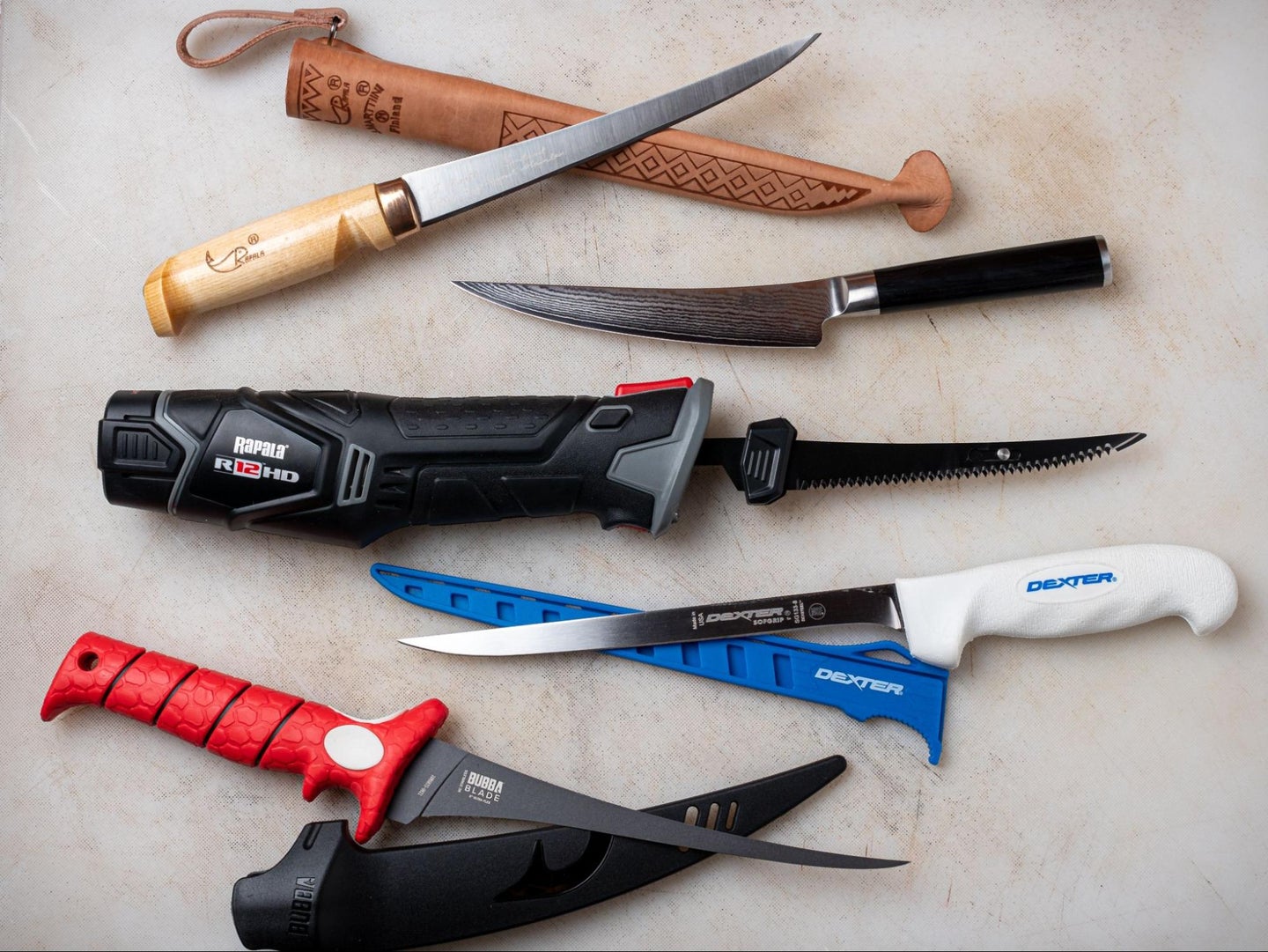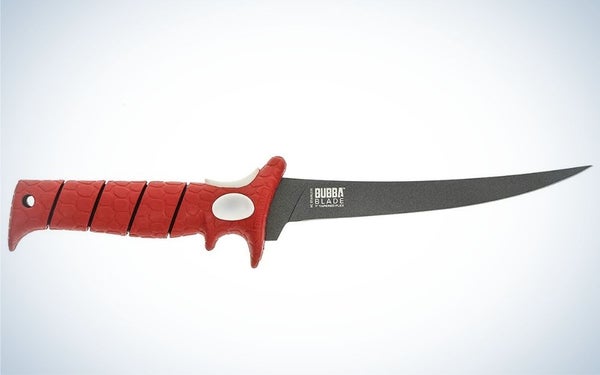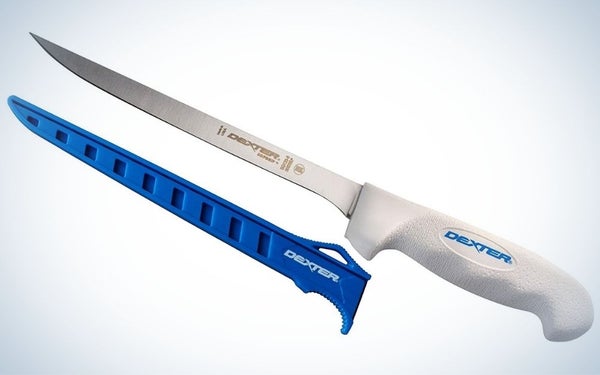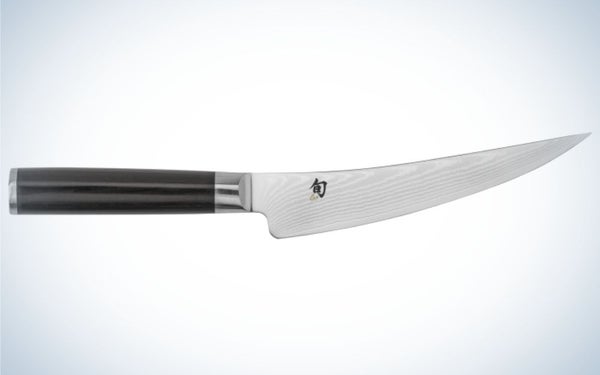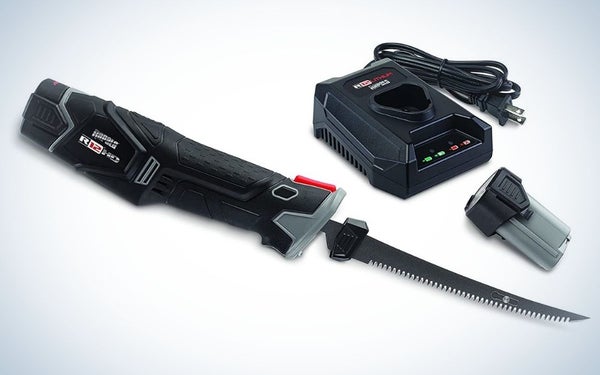| Best Overall |
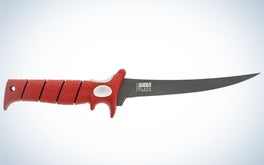
|
BUBBA 7" Tapered Flex | SEE IT |
LEARN MORE
|
Summary
With a super comfortable, safe handle and a sharp Teflon coated blade, the BUBBA 7″ Tapered Flex and the full line of BUBBA fillet knives are the best fillet knives for beginners. |
| Best Budget |
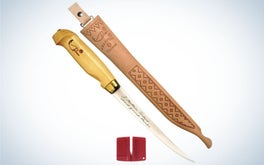
|
Rapala Fish ’n Fillet | SEE IT |
LEARN MORE
|
Summary
The classic birch handle is comfortable in the hand, and the knife comes with a fine leather sheath and a sharpener—everything you need to get started. |
| Best Electric |

|
Rapala R12 Heavy-Duty Lithium Fillet Knife Combo | SEE IT |
LEARN MORE
|
Summary
This knife is affordable, well built, and has a ton of power. The battery lasts forever, and the knife is more lightweight and balanced than other battery powered fillet knives on the market. |
We may earn revenue from the products available on this page and participate in affiliate programs. Learn more ›
Good fillet knives are critical for catch and cook anglers. No one wants to tear their fresh fillets to shreds, and there’s no surer way to do so than going at them with an inferior blade. The best fillet knives need to be durable, flexible, provide plenty of grip, and be easy to sharpen. These characteristics aren’t just a recommendation, they are a necessity for getting the best fillets possible.
As outdoorsmen and women, we spend far too much time, energy, and money on our pursuits to settle for subpar gear. Thankfully, there are plenty of great manual and electric fillet knives to choose from, regardless of how many or what kind of fish you’re working with. I process and cook a lot of fish throughout the course of a year and have found that having the right fillet knives makes all the difference in the world. Here’s a short list of some of the best fillet knives on the market for a variety of users.
- Best Overall: BUBBA 7″ Tapered Flex
- Best for the Money: Dexter Outdoors SOFGRIP 8″ Flexible Fillet Knife with Edge Guard
- Best Budget: Rapala Fish ’n Fillet
- Best Japanese Style: Shun Classic Boning & Fillet
- Best Electric: Rapala R12 Heavy-Duty Lithium Fillet Knife Combo

How We Made Our Picks
Whether I’ve caught them myself or purchased them from the grocery store, I cut up and cook a lot of fish. I also have years of experience breaking down and cooking fish in restaurants. I have filleted piles of panfish, big salmon and trout, saltwater fish, and everything in between. It’s rare that a week goes by that I don’t reach for a fillet knife at least once. I understand what separates the best fillet knives from the rest, and what different types of anglers need to consider when deciding which they should purchase.
Buying the best fillet knife for your individual needs is important if you intend to eat the fish you catch. Picking a knife with the right features and design makes a huge difference in the quality and ease of your work. I used each knife on several different types of fish to get a better understanding of their strengths and weaknesses. Here are the criteria I used to test the knives and determine my selections:
- Sharpness and Edge Retention: A knife is built for cutting. It needs to come sharp and be easy to sharpen. The type of and hardness of the steel, whether it is coated or not, the angle of the bevel, and many other factors contribute to a knife’s ability to take and hold an edge. I cut up a bunch of perch and salmon with each knife, and even tried to dull the blades on cardboard for testing. It only took a few minutes of honing to get them hair shaving sharp again.
- Durability and Cleaning: Fillet knives are tools to be used and abused. Properly cared for, they should last years, if not a lifetime. The materials, design, and build quality of the knife all play big roles in their longevity and performance. They also need to be able to clean up easily so they do not corrode or harbor bacteria. After testing, I left the blades dirty for a few days to see if they would oxidize, and then noted how much effort it took to get them cleaned and sanitary.
- Overall Package: Beyond the quality of the knife itself, it’s important to consider the overall package and the accessories that it comes with. Something as simple as an included sheath makes a big difference whether a knife is worth recommending. This is especially relevant for electric fillet knives that require batteries, chargers, cables, a variety of blades, and a case to carry it all.
Best Fillet Knives: Reviews & Recommendations
Best Overall: BUBBA 7″ Tapered Flex
Why It Made the Cut: With a super comfortable, safe handle and a sharp Teflon coated blade, the BUBBA 7″ Tapered Flex and the full line of BUBBA fillet knives are the best fillet knives for beginners.
Key Features
- Teflon coated blade
- BUBBA Signature grip
- Rubber finger indexing points
Pros
- Comfortable
- Safe handling
- Corrosion resistant
Cons
- Little pricey
The BUBBA 7″ Tapered Flex is the best fillet knife for beginners, but it is by no means strictly an entry level knife. BUBBA knives are well known for their recognizable red handles and razor-sharp, coated blades. The trigger-shaped rubber handle is comfortable and provides a ton of grip so there’s no risk of your hand slipping. The addition of white rubber finger indexing points provides comfort and pressure where you need it. The blade comes super sharp out of the box and is easy to hone and resharpen. The blade’s Teflon coating gives it a non-stick quality, which is great when you have a lot of fish to get through. It also helps protect the blade from damage and corrosion, making it a great choice for saltwater anglers.
While BUBBA offers a variety of awesome knives, the Tapered Flex’s 7- inch blade is the perfect do-it-all length and flex for breaking down most fish. I also like the plastic sheath that comes with it.
Best for the Money: Dexter Outdoors SOFGRIP 8″ Flexible Fillet Knife with Edge Guard
Why It Made the Cut: A USA-made workhorse that has everything you need, and nothing you don’t. It has a high-quality blade, a comfortable and non-slip grip, and is affordable.
Key Features
- DEXSTEEL blade with edge guard
- Medium flex
- SOFGRIP handle
- USA made
Pros
- Sharp and easy to sharpen
- Ergonomic, non-slip handle
- Comes with a plastic sheath
- Affordable
Cons
- No belt loop or tab on sheath
The Dexter Outdoors SOFGRIP Flexible Fillet Knife is the best fillet knife for the money. It’s perfect for beginners and seasoned veterans alike. It’s a traditional, no-frills fillet knife design. The blade has a good amount of flex to glide over bones. It’s super sharp out of the package due to the high alloy, stain resistant DEXSTEEL. The high carbon blade makes it very easy to quickly sharpen and hone compared to a harder steeled knife, so you’re not spending all day fighting to put an edge on it. Both the 7” and 8″ models are great sizes to handle most fish.
The SOFGRIP handle is soft and comfortable in the hand. It is far more slip-resistant than a wooden handled knife. It provides excellent grip even when wet and covered in fish slime. The knife hosts a smooth, sleek design that cleans up easily without a lot of seams or ridges for gunk to get trapped in. It is NSF certified making it a great option for commercial fishermen, guides, and professional cooks. It is also made in the U.S.A. and comes with a blade protector sheath that makes storage and transport much safer for both you and the blade.
Best Budget: Rapala Fish ’n Fillet
Why It Made the Cut: The Rapala Fish ’n Fillet features quality steel that is razor sharp out of the package and easy to sharpen. The classic birch handle is comfortable in the hand, and the knife comes with a fine leather sheath and a sharpener—everything you need to get started.
Key Features
- Birch Handle
- Full-tang Finnish steel blade
- Tooled leather sheath and single-stage sharpener
Pros
- Price
- High-
- Lightweight
- Comes with accessories
Cons
- Slippery wooden handle
- Leather sheath gets grimy
The Rapala Fish ‘n Fillet is the best budget fillet knife on the market. For decades, it has been the gold standard of affordable fishing fillet knives. It comes with everything you need at a price anyone can afford. The Rapala is a time-tested, classic design that has probably cleaned more fish than any other fillet knife on the market. Made by Marttiini, the Finnish makers of Rapala fillet knives for over 50 years, the Fish n’ Fillet is an institution that has sold over 100 million knives to date.
The Fish n’ Fillet’s most notable feature is its progressively tapered, flexible, full-tang stainless steel blade. It is available in four blade sizes, with the 7 ½” model being the most versatile. The high-quality steel holds an edge for a long time and is easy to sharpen when it’s time for a touch-up.
The classic birch handle makes the knife lightweight and comfortable, but the wood can be more slippery than a textured rubber handle when it gets wet. The Fish ‘n Fillet comes with a tooled leather Laplander sheath that protects the blade and looks great, but it’s not as easy to clean as it will collect dirt, slime, and oils over time. The knife also comes with a single-stage sharpener for quick touch-ups on the water. If you’re on a budget or just a sucker for a classic design, the Rapala Fish ‘n Fillet is the best fillet knife for you.
Best Japanese Style: Shun Classic Boning & Fillet
Why It Made the Cut: The Shun Classic Boning & Fillet 6″ is the best fillet knife for those who enjoy Japanese-style knives and value high quality steel. The fact that it doubles as a boning knife also makes it a worthwhile investment despite the price.
Key Features
- VG-MAX cutting core with Damascus cladding
- Full tang construction with ebony PakkaWood handle
- Handcrafted in Japan
Pros
- Wear and corrosion resistant blade
- High quality steel and craftsmanship
- Insanely sharp
Cons
- Expensive
- Not very flexible
The Shun’s Classic Boning & Fillet 6″ knife is the best Japanese-style fillet knife for consumers and professionals alike. Knifemaking and fishing are historic pieces of Japanese culture, and makers have developed a variety of specific designs for fish butchery. While Shun’s Classic Boning & Fillet knife isn’t the most traditional design, it is a great mashup of Japanese and Western ideas.
The Shun Classic Boning & Fillet is shorter and stiffer than most standard fillet knives, offering more control when making fine cuts and working with large-boned fish. It’s also a very capable boning knife for wild game and other meat. The curved, narrow blade is extremely sharp and cuts effortlessly. It has enough flex for boning and skinning, while also being rigid enough to cut through cartilage and even some bone. The proprietary VG-MAX cutting core of the blade is durable and corrosion-resistant. Due to its very fine-grain and 16° bevel, it can be honed to a razor-sharp edge. The blade is clad with 34 layers of stainless Damascus to support the core, adding durability and strain resistance, and preventing food from sticking. It also just looks cool.
Despite its short length, the curvature of the blade is great for the long sweeping knife strokes that characterize a lot of Japanese knife handling. The Shun utilizes a full-length composite tang for improved balance and structural integrity and features an ebony PakkaWood handle that is comfortable and bacteria-resistant.
However, the handle’s smooth finish makes it a bit slippery. Unfortunately, the Shun does not come with a sheath, so it is more intended for home use than on-the-water butchery. The shun is easily the most expensive of the non-electric fillet knives I tested, but if you enjoy Japanese knives and are willing to pay for quality steel, the Shun is one of the best Japanese style fillet knives you can find. We also rounded up some of the best rated boning knives for boning specific situations.
Best Electric: Rapala R12 Heavy-Duty Lithium Fillet Knife Combo
Why It Made the Cut: The Rapala R12 Heavy-Duty Lithium Fillet Knife Combo is affordable, well-built, and has a ton of power. The battery lasts forever, and the knife is more lightweight and balanced than other battery-powered fillet knives on the market.
Key Features
- Long-lasting Lithium battery
- Powerful motor
- Thumb button activation
Pros
- Battery life
- Quick charging
- Light and balanced
- Powerful
Cons
- Price
- Only comes with 2 blades
There are a ton of things that stand out about the Rapala R12 Heavy-Duty Lithium Fillet Knife Combo, making it the best battery-powered, if not the best electric fillet knife out there. Despite being built like a tank, the knife is incredibly lightweight and well-balanced compared to other battery-powered fillet knives I’ve used. You can comfortably use the R12 for a long period of time before your wrist and forearm start to feel it. The thumb button activation is very intuitive for the pushing motion of a fillet stroke. At least subjectively, it feels like the motor is working at a higher rate and with more power than even most corded fillet knives. It doesn’t get bogged down by rib bones or thick fillets like some of its competitors. Compared to something like the classic Mister Twister, buying the Rapala is an investment, but it is a massive improvement in quality that’s not going to burn out after one season.
The portability of a battery-powered fillet knife is really nice, and I found the R12’s battery to be extremely long-lasting and fast charging. Rapala claims the R12’s batteries are rated for nearly 80 hours of continuous use, so you can go many, many sessions without needing a charge. The R12 is by no means cheap, but the price is reasonable when compared to other high-end battery-powered electric fillet knives on the market. While it comes with two batteries, a charger, a nice case, and two different blade sizes, it would have been nice for Rapala to include a few more blade styles. While I’m sure they would prefer you to use their own branded blades, the blades are interchangeable with some other electric knives such as those from BUBBA if you’re ever in a pinch.

Things to Consider Before Buying a Fillet Knife
Length
The length of a fillet knife is one of its most important features. It contributes to how much control you have over the blade while cutting. A shorter blade provides accuracy in the fine, detailed cuts since there is a shorter distance between the tip of the blade and your wrist. However, it’s less ideal for long strokes. A shorter blade is also often more rigid, giving you the ability to exert more energy into a cut. A longer blade, on the other hand, provides greater reach and is often more flexible. The longer reach also makes it easier to work on larger fish and cut in places where you can’t get your hand comfortably.
Here are the most common blade lengths and where they excel:
- 6-inch Blade: A short, 6-inch blade is generally used for small to medium fish and offers control and cutting precision. This size is also useful when you need to do delicate work around big bones on large fish.
- 7-inch Blade: This do-it all blade length works great on most fish.
- 8 to 9+ inch Blade: A blade eight inches or longer offers greater reach and structural integrity for filleting and breaking down large freshwater and saltwater fish.
Flex and Thickness
The amount of flex and thickness of a blade will affect its performance dramatically. A thin, flexible blade glides across and around bones and cartilage far better than a rigid blade, while a rigid blade is better at cutting through. A flexible blade bends with the natural contours of the fish, leading to a cleaner job and less meat loss. A thick, rigid blade has a more robust profile, allowing you to exert more pressure and power into a cut, but is less malleable and forgiving. Knowing how these different factors change the performance of a knife will help you pick the best fillet knife for your needs.
Here are three rough categories that most manual fillet knife blades fall into, and how they perform.
- Stiff and Thick: Best for deboning, removing loins, and cutting fillets into serving size. Slight flexibility at the tip of the knife. Also good for cutting through and around large bones and cartilage, and for making precision cuts and trimming.
- Medium Flex and Thickness: Compromise between power and flexibility. Versatile for most types of fish. Flex point closer to the middle of the knife.
- Flexible and Thin: Best for filleting and skinning. Bends with the natural contours of the fish, gliding over bones and minimizing wasted meat. Less able to exert power into the knife. Flex point closer to the middle or base of the blade.

Volume
The amount and type of fish you expect to process are worth considering when choosing the best fillet knife for your needs. A commercial fisherman in Alaska is going to have different requirements than an ice fisherman in Michigan. If you only fish a few times per year on local water, a traditional 7-inch fillet knife might be all you need. If all you do is fish, and travel a lot to do it, one knife length and style isn’t going to cut it. If you routinely find yourself cleaning hundreds of crappie and walleye a year, you may want to think about getting an electric fillet knife.
Portability
The overall size, weight, and profile of a fillet knife is something to consider based on the type of fishing you do the most. A lightweight option that comes with a sheath or scabbard might be the best fillet knife for beginners and anglers who travel a lot to fish. Whereas an electric or a high-quality fillet knife is better suited for high volume home use. The availability of power near the places you fish may also determine whether a corded or battery-powered option is the best electric fillet knife for your needs. You check also check out these best fishing knives for other applications.
Price
You don’t need to spend a fortune to get your hands on an awesome fillet knife. Even the best fillet knives are not terribly expensive. But there are premium options out there that will come at a higher price. Most fillet knives on the market are well under a hundred dollars, with some of the best electric fillet knives costing a bit more.
FAQs
Q: What makes a good fish filleting knife?
The best fillet knives need several important qualities. They need to be sharp and easy to sharpen, clean up easily, and provide a good grip when wet and slimy. A good fish filleting knife also needs to be the right length and have the right amount of flex for the job. The best electric fillet knives need to be lightweight, balanced, and powerful enough to cut through anything you throw at them. They also need to have a quality motor that can stand the test of time.
Q: How much does a fillet knife cost?
Most fillet knives are relatively inexpensive. They average anywhere from $20 to $80, with some of the higher-end Japanese and electric fillet knives going for $100 to $300 plus.
Q: What is the best length for a fish filleting knife?
The best length for a fillet knife depends on personal preference and the type of fish you need to break down. I think a 7-inch knife is the best do-it-all length if I could only pick one.
Q: How should I maintain my fillet knives?
The most important thing you can do to maintain your fillet knife is to clean it right after every use, especially if you’re fishing in saltwater. You do not want rust to develop on the blade, and the best way to avoid this is to wash it with hot water and soap after you’re done. You should also sharpen your knife regularly to make sure it maintains a sharp blade, which will improve the quality of your fillets and keep you from accidentally cutting yourself.
Best Filet Knives: Final Thoughts
- Best Overall: BUBBA 7″ Tapered Flex
- Best for the Money: Dexter Outdoors SOFGRIP 8″ Flexible Fillet Knife with Edge Guard
- Best Budget: Rapala Fish ’n Fillet
- Best Japanese Style: Shun Classic Boning & Fillet
- Best Electric: Rapala R12 Heavy-Duty Lithium Fillet Knife Combo
No tackle box or home kitchen is complete without a fillet knife. While you want the best fillet knife you can find, you don’t need to find the perfect one, because having a variety of different lengths, flexes, and styles for different jobs is really the best way to go. Most fillet knives are extremely affordable, and beyond the handcrafted steel and high-end electric knives, it won’t hurt the bank account to collect a few.
When it comes to feeding yourself and your loved ones, it’s worth having the right tool for the job. The best fillet knives have a few things in common. They are durable, sharp, easy to sharpen, provide plenty of grip, and are reasonably priced. If you’re in the market, all of these knives are excellent choices for turning your hard-earned catch into dinner.
Why Trust Us
For more than 125 years, Field & Stream has been providing readers with honest and authentic coverage of outdoor gear. Our writers and editors eat, sleep, and breathe the outdoors, and that passion comes through in our product reviews. You can count on F&S to keep you up to date on the best new gear. And when we write about a product—whether it’s a bass lure or a backpack—we cover the good and the bad, so you know exactly what to expect before you decide to make a purchase.
